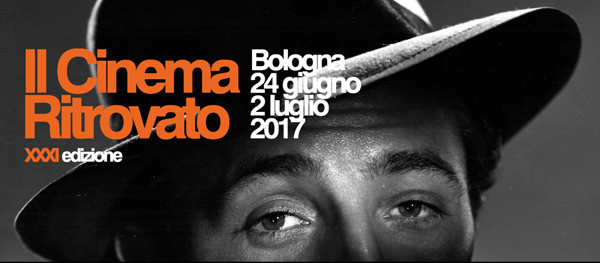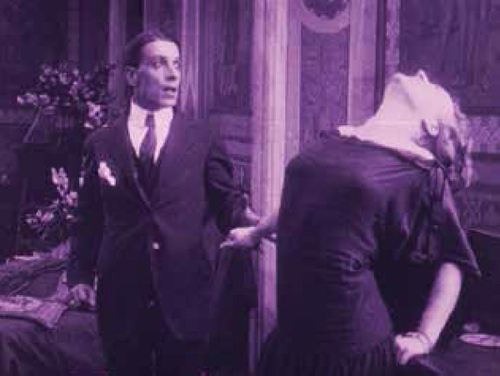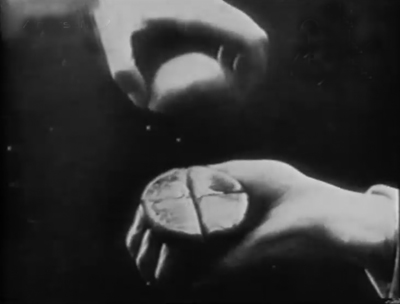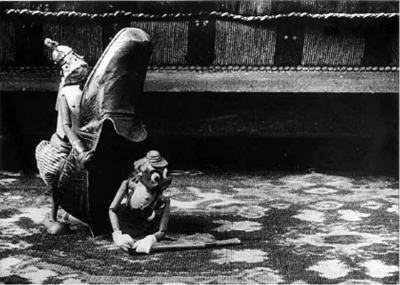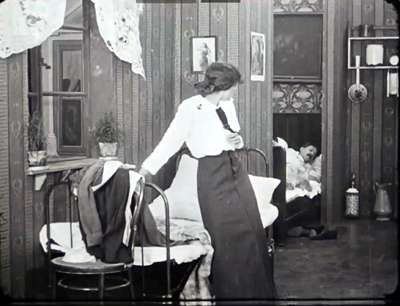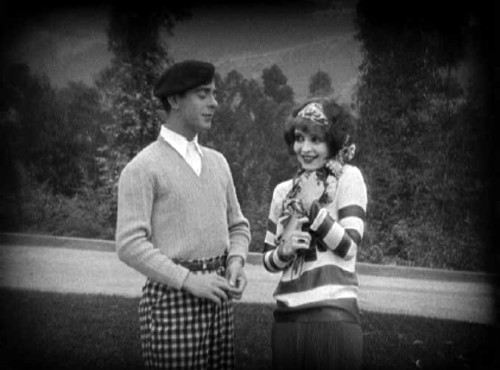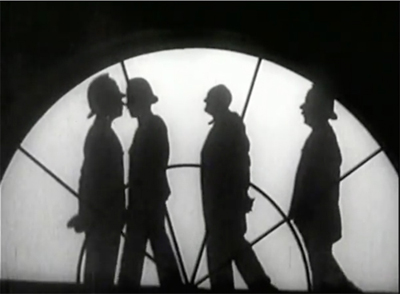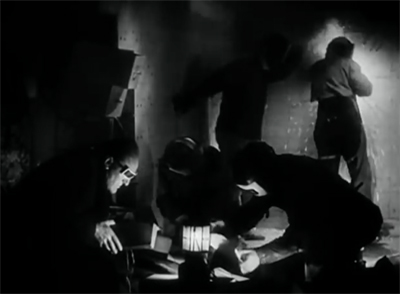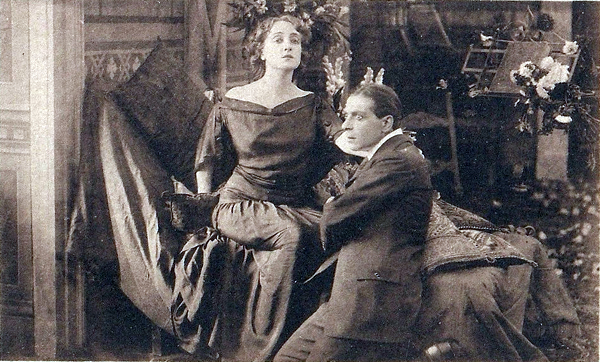DB here:
Immense scale and teeming activity are nothing new to Il Cinema Ritrovato [2], the Cineteca di Bologna’s annual jamboree of restored and rediscovered films from all over the world. The scorching heat–90 degrees and more for the first few days–only makes it seem more intense than usual.
Kristin and I had to miss the last Ritrovato session, but we’re convinced that this nine days’ wonder is still the film-history equivalent of Cannes.
In one way, your choice is simple. You can follow one or two threads–say, the Robert Mitchum retrospective or the Collette and cinema one or the classic Mexican one, or whatever–and dig deep into that. Or you can skip among many, sampling several, smorgasbord-style.
In practice, I think most Ritrovatoians pursue a mixed strategy. Settle down one day for a string of, say, early Universal talkies and another day check out the restored color items. On off-days roam freely. The problem is you will always, always miss something you would otherwise kill to see.
At the start, I plumped for 1910s films, particularly Mariann Lewinsky’s reliable 100 Years Ago cycle. My other must was the Japanese films from the 1930s; half of the titles brought by Alexander Jacoby and Johan Nordström, were new to me. As of this writing, I haven’t seen those, but I have dug into the 1917 items. And I indulged myself with, no surprise, some gorgeous Hollywood things.
1917 and all that
Malombra (1917).
If you caught any of my dispatches from Washington DC earlier this year (starting here [4]) you know I was burrowing deep into American features of the 1910s That complemented several years of archival work on European films of the same period. So of course the chance to sample 1917 features from Hungary, Poland, Russia, and elsewhere was not to be passed up.
Some superb ‘teens films I just skipped through familiarity. Gance’s Mater Dolorosa (1917), possibly the most patriarchal film in the thread, remains tremendously inventive at the level of silhouette lighting and continuity cutting (a huge variety of camera setups during the fatal love tryst). And one of the very greatest directors of the period, Yegenii Bauer, was represented by two of his last films, The Revolutionary and Towards Happiness. I’ve studied both elsewhere, in On the History of Film Style, Figures Traced in Light, and online [5]. Even so, I found plenty to keep me busy.
One of the main threads was devoted to Augusto Genina, a director with an astonishingly long and prolific career. Probably best known for Prix de Beauté (Miss Europe, 1930), he started in 1913 and made his last film in 1955. His 1910s films confirm that Italy was producing many films of striking beauty and audacity in those years.
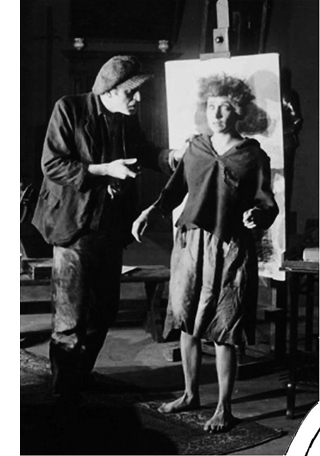 [6]Take Lucciola (1917, right), the story of a waif who befriends a harbor layabout but leaves him to become a society princess admired by a debonair painter and three bulbous plutocrats. Pivoting from social satire to low-life melodrama, the film makes use of bold lighting and meticulous cutting, usually along the lens axis. (Like many European films of the ‘teens, Lucciola lies sort of between tableau cinema and the faster-cut American style.) All in all, a strong, tight movie.
[6]Take Lucciola (1917, right), the story of a waif who befriends a harbor layabout but leaves him to become a society princess admired by a debonair painter and three bulbous plutocrats. Pivoting from social satire to low-life melodrama, the film makes use of bold lighting and meticulous cutting, usually along the lens axis. (Like many European films of the ‘teens, Lucciola lies sort of between tableau cinema and the faster-cut American style.) All in all, a strong, tight movie.
In a similar vein is Addio, Giovenezza! (1918), adapted from a popular song. This one, screened in an open-air venue thanks to an arc-lamp projector, is another sad Genina tale. A careerist law student abandons his rooming-house maid for a social butterfly with a wardrobe to die for. Apart from one startling scene in a milliner’s shop, illuminated mostly by spill from the street, the lighting isn’t as daring as in Lucciola. Still, the poignant plot is again inflected by comic touches, proceeding largely from the hero’s nerdish fellow student. Genina redid the story again in 1927, and I’m hoping to catch that screening.
Malombra (1917), starring the diva Lyda Borelli, was by the great Carmine Gallone. (I’ve discussed La Donna nuda [7] and Maman poupée [8] hereabouts.) After moving into a castle, Marina becomes possessed by the spirit of the woman who died there. Our heroine’s job is to take revenge on the faithless husband. Flirtatious and iron-willed, Borelli dominates her scenes with shifts of stance, sudden freezes, rapid changes of expression, languorous arm movements, and, at one climax, a swift undoing of her hair that lets it all tumble wildly around her face. The print, needless to say, was superb.
In a lighter vein, if you wanted proof of the inventiveness of ‘teens Italian film, you couldn’t do better than Wives and Oranges (Le Mogli e le arance; 1917). This agreeably silly movie sends a bored young man to a spa populated by incredibly aged parents and a bevy of scampering daughters. With an avuncular friend, Marcello capers with the girls before settling on the most modest one as his wife. But her friends aren’t disappointed because our hero’s pals come for a visit and get roped into matrimony too.
Wives and Oranges has a remarkable freedom of narration. The film uses montage sequences with a fluidity that is rare at the time. To convey the boredom of Marcello’s daily routine, a string of quick shots is punctuated by changing clock faces. Later, the idea of finding one’s ideal love mate by matching halves of oranges is presented via an absurd montage of old folks, youngsters, babies, and just abstract hands, all wielding oranges.
Marcello’s paralyzing dilemma of choice is given as a nondiegetic insert of a donkey unable to decide between a hay bale and a bucket of water. These flashy devices keep us interested in a situation that, in script terms, is probably stretched too thin–although when things slow down you can count on the daughters forming a chorus line and zigzagging down the road or popping out from under the dinner table one by one.
Almost as lightweight was The War and Momi’s Dream (La Guerra e il sogno di Momi, 1917), by the great Segundo de Chomón, who moved among France, Spain, and Italy making fantasy films of many types. This one is largely meticulous puppet animation, in which a boy’s toys come to life and enact–at the height of the World War–their own combat.
Trick and Track marshall other toys to play out some seriocomic clashes, including a burning farmhouse and one astonishing shot of an entire town landscape, covered in a long camera movement. Again, there’s no underestimating the sheer technical audacity of Italian cinema of these days.
There’s always an exception, of course. The late David Shepard left us, among much else, Shepard’s Law of Film Survival: The better the print, the worse the movie. A good example is La Tragica fine di Caligula Imperator (1917), signed by Ugo Falena. It’s surprisingly retrograde for an Italian film of the period. Neither the staging (flat, distant) nor the cutting (minimal) nor the lighting (little modeling) is much in tune with contemporary norms. The problem may be the immense sets, which are indeed impressive but which seem to encourage the actors to a hard-sell technique.
The most amped-up is Caligula himself. Playing a mad Roman emperor often tempts any actor to gnaw table legs. But as an example of what a silent film really could look like, Caligula should be required viewing for anybody who sneers at Those Old Movies. If Christopher Nolan saw it, he’d demand to shoot on orthochrome nitrate.
Other 1917 features included The Soldier on Leave, from Hungary, and Stop Shedding Blood!, by the great Russian director Jakov Protazanov. The former was restored from a 17.5mm copy, the latter was missing the two central reels. The Protazanov in particular had some sharp staging in depth and rich sets.
In the same batch was Pola Negri’s screen debut in Bestia (1917, imported to the US as The Polish Dancer). In a fine copy, you could appreciate the bouncy but sultry screen presence that made her a star. And as often happens with films from anywhere in this period, the sets sometimes play peekaboo with the action. Pola, after a night out with her thuggish lover, sneaks back to her bed while her father snores in the background, caught in a slice of space.
Back in the USA
Kid Boots (1917).
The 1917 American entry was a strong, unpretentious Western by Frank Borzage, Until They Get Me. It’s missing some scenes in the middle, but it remains a forcefully quiet movie. The only gunplay takes place at the start, when a man racing to get to his wife in childbirth is forced into a gunfight. He kills the drunkard who provoked it, but by the time he reaches his home, his wife is dead. Now he must flee Selwyn, a mountie. Stealing a horse, he picks up an orphan girl fleeing an oppressive household. The rest of the film will intertwine the fates of the three, leading to a surprisingly civilized resolution.
Borzage is one of the many great directors–De Mille, Dwan, Walsh, Ford, Brown, King, Barker–who started doing features in the mid-teens. Most had long careers. They mastered the emerging norms of Hollywood continuity cinema and learned to deploy them with tact and precision. Just the timing of the reaction shots in Until They Get Me is worth study.
Frank Tuttle started in features a bit later, in 1922, but Kid Boots (1926), my first movie of the Ritrovato, showed complete mastery of comic storytelling. Eddie Cantor, a fired tailor, becomes amanuensis to Tom Sterling, a man-about-town in the throes of a divorce. The twist is that his wife, learning of Tom’s new inheritance, wants to halt the divorce by sharing his bed again. Eddie’s job is to keep the wife and the lawyers at bay until the divorce becomes final. Into this tangle plops perky Clara Bow in her first film after her breakout role in Mantrap (also 1926). You could watch her cock her chin and roll her eyes for hours. She steals the picture from Billie Dove.
The gag situations come thick and fast, with one high point being Eddie’s efforts to get Clara jealous by recruiting a strategically open door to help him pretend that his left arm actually belongs to Tom’s seductive wife. The whole thing culminates in a breathless chase on horses along a treacherous mountain pass. Eddie and all the others keep things lively, and Tuttle’s direction is exacting.
I strayed from the ‘teens again at Dave Kehr’s urging. Of Dave’s magnificent MoMA restorations, I caught William K. Howard’s Sherlock Holmes (1932). Apart from a wild-eyed Ernest Thesiger and an imperturbable Clive Brook, it boasts an abstract opening of silhouettes and confrontational close-ups and a conclusion of percussive flashes as Moriarty’s gang torches its way into a bank.
Ace cinematographer George Barnes had a field day with this one.
That was followed by Tay Garnett’s Destination Unknown (1933), a tense drama of a crisis on a bootlegging ship immobile on a windless sea. Hard, fast playing by Pat O’Brien and Alan Hale was offset by the leisurely presence of none other than Ralph Bellamy, aka Jesus of Nazareth. Don’t ask; just see it.
More from me, and Kristin, later in the week.
Thanks to Guy Borlée for a great deal of assistance on this entry. Thanks as well to the programmers and staff of the festival, especially Gian Luca Farinelli and Mariann Lewinsky.
The Ritrovato site is constantly updated [14]. For our earlier Ritrovato communiqués, go here [15].
Malombra (1917; production still).
